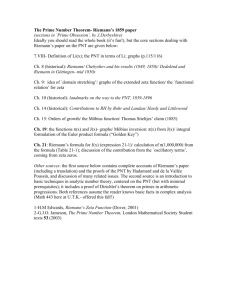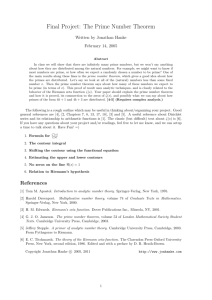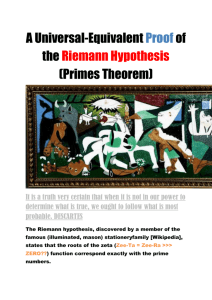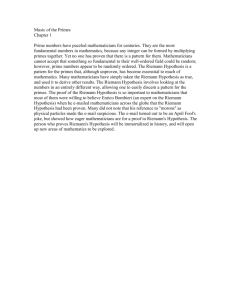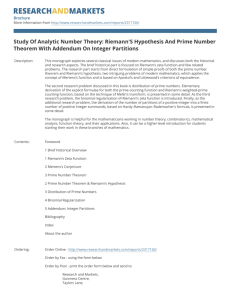Riemann`s Zeros and the Rhythm of the Primes
advertisement
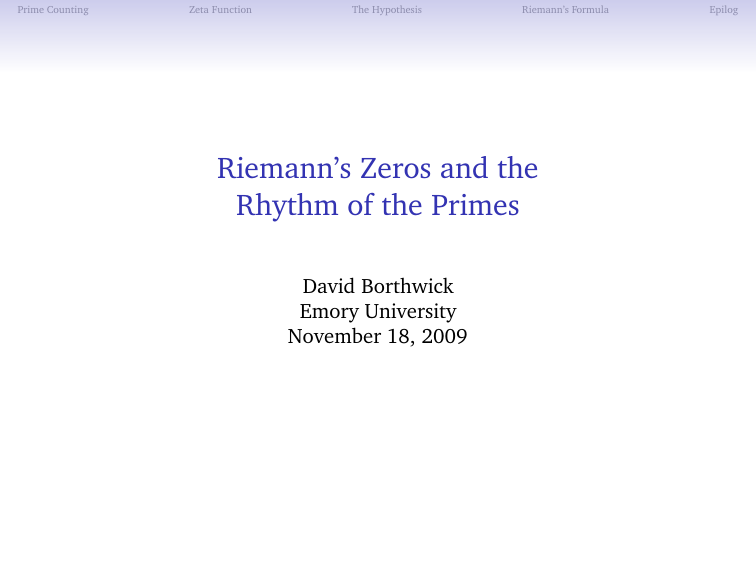
Prime Counting
Zeta Function
The Hypothesis
Riemann’s Formula
Riemann’s Zeros and the
Rhythm of the Primes
David Borthwick
Emory University
November 18, 2009
Epilog
Prime Counting
Zeta Function
The Hypothesis
Riemann’s Formula
Bernhard Riemann, 1826–1866
“On the Number of Primes Less Than a Given Magnitude”
7 page paper offered to the Monatsberichte der Berliner Akademie on
October 19, 1859. The exact publication date is unknown.
Epilog
Prime Counting
Zeta Function
The Hypothesis
Riemann’s Formula
The counting function
We’ll use p to denote a prime number,
p ∈ 2, 3, 5, 7, 11, 13, 17, 19, . . . .
The prime counting function is
π(x) := # primes p ≤ x .
40
π(x)
20
100
200
Epilog
Prime Counting
Zeta Function
The Hypothesis
Riemann’s Formula
Gauss’s conjecture
On a larger scale, the graph looks remarkably smooth:
8000
π(x)
4000
50,000
In 1792, Gauss conjectured that π(x) ∼
100,000
x
.
log x
(This means that π(x)/( logx x ) → 1 as x → ∞.)
Epilog
Prime Counting
Zeta Function
The Hypothesis
Riemann’s Formula
Gauss could compute π(x) up to x = 3, 000, 000.
x
10
102
103
104
105
106
107
108
109
1010
π(x)
4
25
168
1229
9592
78498
664579
5761455
50847534
455052511
Convergence is rather slow. . .
x/ log x
4
22
145
1086
8686
72382
620421
5428681
48254942
434294482
ratio
0.921
1.151
1.161
1.132
1.104
1.084
1.071
1.061
1.054
1.048
Epilog
Prime Counting
Zeta Function
The Hypothesis
Riemann’s Formula
Gauss later realized that the “log integral” function,
Z x
dt
Li(x) :=
(also ∼ logx x ),
2 log t
would give a better approximation.
x
10
102
103
104
105
106
107
108
109
1010
π(x)
4
25
168
1229
9592
78498
664579
5761455
50847534
455052511
Li(x)
6
30
178
1246
9630
78628
664918
5762209
50849235
455055615
π(x)/ Li(x)
0.64876
0.82984
0.94590
0.98625
0.99607
0.99835
0.99949
0.99987
0.99997
0.99999
The claim π(x) ∼ Li(x) became the Prime Number Conjecture.
Epilog
Prime Counting
Zeta Function
The Hypothesis
Riemann’s Formula
The zeta function
Euler (1748) had studied the series
ζ(s) := 1 +
1
1
1
+ s + s + ...,
2s
3
4
(convergent for s > 1). Euler factored this over the primes,
ζ(s) = 1 + 21s + 41s + . . . 1 + 31s + 91s + . . . 1 + 51s + . . . · · · ,
and used geometric series,
k
∞ X
1
k=0
to conclude
ps
−1
1
= 1− s
,
p
−1
Y
1
1− s
ζ(s) =
.
p
p
Epilog
Prime Counting
Zeta Function
The Hypothesis
Riemann’s Formula
Before Riemann, the zeta function was studied for real s > 1.
20
ζ(s)
10
1
2
3
From lims→1 ζ(s) = ∞, we can deduce that
1 1 1 1
1
+ + + +
+ · · · = ∞.
2 3 5 7 11
Epilog
Prime Counting
Zeta Function
The Hypothesis
Riemann’s Formula
Analytic continuation
Riemann’s innovation was to consider ζ(s) for complex values of s.
-1
0
1
1
2
3
-1
Re ζ(s)
0
1
1
2
3
Im ζ(s)
4
2
2
0
0
Euler’s definition works for Re s > 1, and it appears we can bypass the
obstacle at s = 1.
Epilog
Prime Counting
Zeta Function
The Hypothesis
Consder a simple example:
Z
∞
t−s dt =
1
Riemann’s Formula
1
.
s−1
This integral converges for Re s > 1.
But the expression on the right makes sense for any complex s 6= 1.
We can use this formula to extend the meaning of the integral. For
example, we could say
Z ∞
1
t2 dt = − .
3
1
Because the extension is an analytic function, complex analysis tells
that such an extension is uniquely defined.
Epilog
Prime Counting
Zeta Function
The Hypothesis
Riemann’s Formula
Riemann’s zeta function
Riemann extended ζ(s) to all s 6= 1 by deriving the formula
Γ(1 − s)
ζ(s) =
2πi
Z
+∞
+∞
(−x)s dx
,
ex − 1 x
where the integral is taken over a contour in the complex plane:
(The result equals
P
1
ns
for Re s > 1 and is analytic for s 6= 1.)
With Riemann’s extension, we can make sense of divergent sums:
1 + 2 + 3 + 4 + · · · = ζ(−1) = −
1
.
12
Epilog
Prime Counting
Zeta Function
The Hypothesis
Riemann’s Formula
Epilog
Here’s Re ζ(s) in the original domain, Re s > 1.
-20
5
0
-10
-5
10
0
0
10
-10
Prime Counting
Zeta Function
The Hypothesis
Riemann’s Formula
Epilog
Here’s Re ζ(s) after Riemann’s extension.
-20
5
0
-10
-5
10
0
0
10
-10
Prime Counting
Zeta Function
The Hypothesis
Riemann’s Formula
Riemann zeros
Using the contour integral formula for ζ(s), Riemann observes
ζ(s) = 0,
for s = −2, −4, −6, . . . .
He also shows that all other zeros lie in the strip 0 ≤ Re s ≤ 1.
critical strip
20
10
trivial zeros
-4
-2
0
-10
-20
critical line
1
Epilog
Prime Counting
Zeta Function
The Hypothesis
Riemann’s Formula
Riemann’s claims about the zeros
1. The number of zeros ρ in the critical strip with 0 ≤ Im ρ ≤ T is
about
T
T
T
log
−
.
2π
2π
2π
(Proven by Mangoldt in 1905.)
2. One finds about this many roots on the critical line, . . .
(Proven by Selberg in 1942: a positive fraction
of the zeros lie on the critical line.)
3. . . . and it is very likely that they all do.
The Riemann Hypothesis!
“One would of course like to have a rigorous proof of this, but I
have put aside the search for such a proof after some fleeting
vain attempts. . . ”
Epilog
Prime Counting
Zeta Function
The Hypothesis
Riemann’s Formula
The Riemann Hypothesis
Any non-trivial zero ρ of ζ(s) has Re ρ = 21 .
|ζ(s)|−1
We’ve verified this for the first 10,000,000,000,000 zeros!
In terms of containing the zeros in a vertical strip, the best we can do
is to replace 0 ≤ Re ρ ≤ 1 by 0 < Re ρ < 1.
Epilog
Prime Counting
Zeta Function
The Hypothesis
Riemann’s Formula
Chebyshev’s counting function
In counting primes convenient to:
1. Include prime powers pk , for k = 1, 2, 3, . . . .
2. Assign to each pk the weight log p.
This defines the Chebyshev function
X
ψ(x) :=
log p.
pk ≤ x
200
100
100
200
Epilog
Prime Counting
Zeta Function
The Hypothesis
Riemann’s Formula
Epilog
The two counting functions are related by
π(x) +
1
1
2
2 π(x )
+
1
1
3
3 π(x )
+ ··· =
Z
2
x
dψ(t)
.
log t
This gives two equivalent forms for the Prime Number Conjecture:
π(x) ∼ Li(x)
⇐⇒
ψ(x) ∼ x.
200
40
Li(x)
π(x)
ψ(x)
100
20
100
200
100
200
Prime Counting
Zeta Function
The Hypothesis
Riemann’s Formula
Riemann’s explicit formula
Riemann gives a formula for π(x) in terms of the non-trivial zeros ρ of
the zeta function. This is equivalent to
ψ(x) = x −
X xρ
ρ
ρ
+
X x−2n
n
2n
− log 2π.
(Proven by Mangoldt in 1895.)
Riemann’s strategy for the Prime Number Conjecture amounts to
X xρ
to prove that ψ(x) ∼ x.
estimating
ρ
ρ
Epilog
Prime Counting
Zeta Function
The Hypothesis
Riemann’s Formula
Riemann’s formula reveals a deep connection between primes and
zeros.
To illustrate this, consider the derivative of ψ(x),
ψ ′ (x) = 1 −
X
ρ
xρ−1 −
1
.
− 1)
x(x2
Since ψ(x) is a step function that jumps at each prime power pk , ψ ′ (x)
should be zero except for spikes at
2, 3, 4, 5, 7, 8, 9, 11, 13, 16, 17, 19, . . . .
Epilog
Prime Counting
Zeta Function
The Hypothesis
In the sum
ψ ′ (x) = 1 −
X
xρ−1 −
ρ
Riemann’s Formula
1
,
x(x2 − 1)
each conjugate pair {ρ, ρ} contributes a waveform
xρ−1 + xρ−1 .
2xRe ρ−1
For each waveform, Re ρ
amplitude and Im ρ
frequency.
Epilog
Prime Counting
Zeta Function
The Hypothesis
Riemann’s Formula
By adding up these waveforms, we can see the distribution of prime
powers emerge.
Approximating ψ ′ (x) with 1 pair of zeros:
0
0
5
10
15
20
Epilog
Prime Counting
Zeta Function
The Hypothesis
Riemann’s Formula
By adding up these waveforms, we can see the distribution of prime
powers emerge.
Approximating ψ ′ (x) with 10 pairs of zeros:
0
0
5
10
15
20
Epilog
Prime Counting
Zeta Function
The Hypothesis
Riemann’s Formula
By adding up these waveforms, we can see the distribution of prime
powers emerge.
Approximating ψ ′ (x) with 100 pairs of zeros:
0
0
5
10
15
20
Epilog
Prime Counting
Zeta Function
The Hypothesis
Riemann’s Formula
Rhythm of the primes
The Riemann zeros define the oscillatory modes that generate the
distribution of prime numbers.
The Riemann Hypothesis claims a perfect balance among these
modes: all modes have equal amplitudes.
Epilog
Prime Counting
Zeta Function
The Hypothesis
Riemann’s Formula
If RH is false, then at least one “note” is louder than the others:
“If anything at all in our universe is correct, it has to be the
Riemann Hypothesis, if for no other reasons, so for purely
esthetical reasons.”
- A. Selberg
Epilog
Prime Counting
Zeta Function
The Hypothesis
Riemann’s Formula
Prime Number Theorem
Riemann’s strategy does work: We can prove that
Re ρ < 1 for all ρ,
which implies
1 X xρ
= 0.
x→∞ x
ρ
ρ
lim
By the explicit formula for ψ(x), this means
ψ(x) ∼ x,
or
π(x) ∼ Li(x).
(1896: Hadamard and de la Vallée-Poussin)
Epilog
Prime Counting
Zeta Function
The Hypothesis
Riemann’s Formula
Cautionary tale
So we’ve checked 1013 zeros. Is that strong evidence?
Consider another Gauss conjecture: that π(x) ≤ Li(x) always.
40
20
100
200
We now know this to be true for all x ≤ 1014 . However, . . .
Littlewood proved in 1914 that π(x) and Li(x) cross infinitely often!
No value of x for which π(x) > Li(x) is currently known.
Epilog



